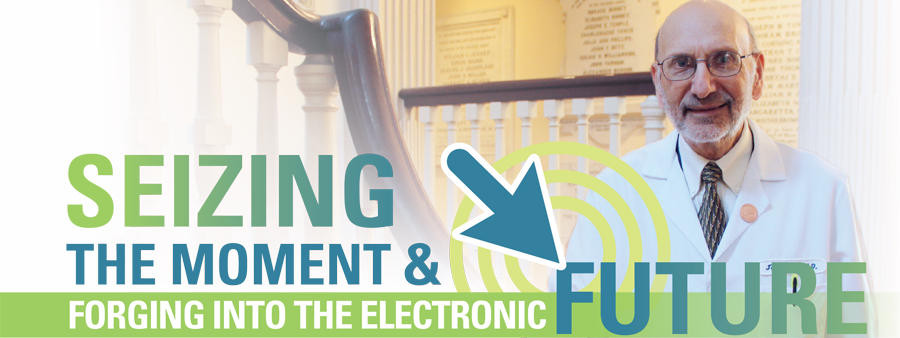
A year and a half has passed since Pennsylvania Hospital rolled out the innovative and transformative PennChart electronic health record (EHR), advancing our traditional documentation system and paving the way for PennChart’s adoption across the health system. PennChart has changed the way patient data is distributed and utilized by clinicians and opened up new possibilities for integrating research with clinical care – and we’re still learning how to optimize it further. Integral to the implementation process was PAH’s Joel Betesh, MD, a clinical professor of Medicine and medical officer of Clinical Informatics, who was invited to highlight Penn’s print-to-electronic migration earlier this month at the 2018 American Medical Informatics Association (AMIA) Clinical Informatics Conference in Scottsdale, Ariz. (Side note: the conference committee reviewed over 200 submissions, and Penn Medicine faculty and staff snagged an incredible nine panel spots!)
AMIA describes their annual event as a “doing” conference that encourages attendees to share strategies that have enhanced their daily practices and to provide the tools to other institutions in order to advance the healthcare industry as a whole. Drawing from that collaborative spirit, Betesh, along with HUP’s Kai Xu, MD, and John D. McGreevey III, MD, both associate professors of Clinical Medicine, encouraged attendees to “seize the moment” for progress offered by EHRs and assured them that while the PennChart model may seem ambitious, rapid, successful change is possible. Their presentation detailed the pitfalls of outdated paper documentation that Penn had faced – limited access to provider notes, excessive personalized templates, illegible handwriting, important assessments obscured by unnecessary details, and unstandardized notation methods – and demonstrated how transitioning to a single EHR across all entities and all care settings, including inpatient, outpatient, and home care, offered a “once-in-a-generation opportunity” to evolve and cut down on a bloated system.
“We’ve gone from having multiple siloed computer programs across the entities to one EHR utilized by the entire health system – from somewhere around 3,000 separate order sets to under 1,000,” echoed John Brennan, MSN, RN, CNHA, PAH’s clinical director of Nursing, who also served as the hospital’s nursing lead during the PennChart roll-out. “The needs aren’t exactly the same at both PAH and PPMC, for example, so optimizing the EHR has required a lot of discussions about best practices and compromises, but even though it can be challenging, the whole gamut of clinical staff involved with a patient’s care now can maintain better, clearer communication.”
PAH and Chester County Hospital were the health system’s pioneering PennChart-ers, and staff’s experiences informed the transition at the other entities. In studying the subsequent roll-out at HUP, Betesh, Xu, and McGreevey noted that streamlining the electronic note templates to include only necessary details that can’t be found elsewhere in the EHR, as well as sticking to the APSO format – assessment, plan, subjective, objective – in progress notes were largely successful, with only a few deviations.
“Going from paper to the EHR was a huge change on its own, but we also decided to push for leaner, more readable notes, and for a switch from the SOAP format to the APSO format – all at once,” Betesh said. “We initially thought that it might be too much change to handle, but the alternative was having everyone transition to a new system, then six months later change part of that system that they had just started adapting to, then change something again. I think a little bit of stress in the beginning made for a better outcome in the long run.”
The result has been leaner and clearer documentation, increased efficiency, improved communication across departments, better monitoring of patients throughout their care without starting from scratch, and a new standardized electronic model that can more easily be molded and adapted for future patient needs and continued technological advancements. And it’s not just the clinicians who have benefitted from this seized moment.
“This has a significant impact on the patient’s experience, too,” Brennan said. “If they begin their care journey at Pennsy and move onto GSPP for rehab, for instance, their care team will be able to immediately pull up their history and better serve their needs safely and efficiently. The patient’s story is clear to staff from beginning to end.”
With more PennChart changes on the horizon (new modules, shared notes that are visible to patients to give them further access to their own care, and more), Betesh hopes that those who attended his AMIA panel and are planning EHR roll-outs at their own institutions are inspired to not shrink from the challenge of tackling multiple problems at once. “It’s a huge change, but it’s also hugely beneficial to everyone,” he said. “Whether they follow our model or not, I’m hoping they are able to think big.”